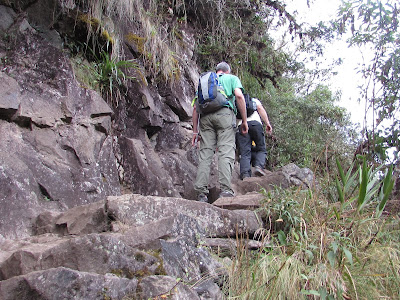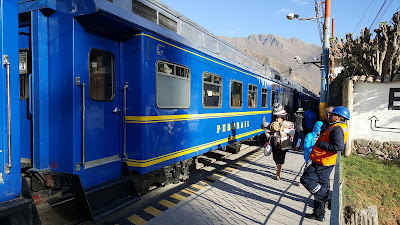When we arrive in Machu Picchu, we can't see Huayna Picchu due to the low clouds.
We make our way through the ruins to the entrance for the hike.
Then we wait for the gates to open for the trail up Huayna Picchu. We will have to sign in with our departure time, and sign out again when we return.
As we wait, we see the clouds slowly lifting.
Terry and Jen are anxious to get to the top before it gets crowded up there, so the rest of us tell them to go on ahead.
From a distance Huayna Picchu looks like a technical climbing endeavor, but it is in fact just a steep hike with some sections that require the use of both hands and feet to scramble upwards, but no technical skills or climbing tools.
There are sections that include railings and cables for support.
It's a bit strenuous and we need to watch our step; but the view as we stop to catch our breath is wonderful.
And we climb higher and higher.
Machu Picchu is getting smaller and smaller.
At this point we are at the terraces, almost to the top but not quite. The remaining portion of the hike involves a very steep and narrow climb, which is for one-way traffic only. So,if you start up, you are committed to go all the way to the top.
Terry and Jen went on to the very top; Joyce, Donato, and Ernie decided the terrace level is far enough. Mark continued the climb up.
The total ascent is just over 1,000 feet with the summit at a steep angle above the ruins of Machu Picchu.
My favorite photos...
Back down at the trail head, we celebrate our accomplishment.
Climbing Huayna Picchu was definitely one of the highlights of our visit to Machu Picchu.
After our hike, we took the bus back to Aquas Calientes in time to catch the 1:37 pm train to Ollantaytambo and then meet our driver, who took us back to Cusco to spend the night.
The next day we did a little shopping and then watched school children perform in the main square before we headed to the airport for the flight to Lima and then back home.
We booked the Galapagos week and the days in Machu Picchu through Quasar Expeditions. It was a most wonderful trip and we highly recommend this company.
Once home we only had 4 days before we left on our next adventure.....the Grand European River Cruise.



















































































